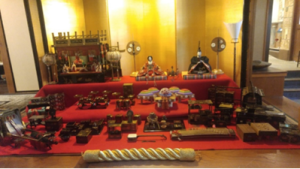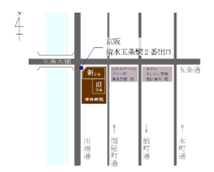Hina dolls in the lunar calendar, in Kyoto on April 3rd
Yoshie Doi
 |

Head office map |
Meiji-era hina dolls displayed at the Hanbei Fu head office, taken on March 2, 2023
The other day, when I visited the Hanbei Fu head office (https://www.hanbey.co.jp/abouthanbey/sabo/), I was able to see the hina dolls. I fell in love with Hina-san with a very kind face. It takes a day for her to decorate it, and it takes another day to finish it.
At old families in Kyoto, hina dolls are displayed according to the lunar calendar until April 3rd. March 3rd of the lunar calendar was “Joshi no Harae”, which was the peach festival. Joshi refers to the first day of the Mi (dolls festival) in March, but it is not always the 3rd. The Nihonshoki and Zoku Nihonshoki record that the emperor had a banquet with people of the fifth rank and above on Joshi no Hi in March. It seems that it was an annual event from the Nara period to the middle of the Heian period.
In China, since the Wei Dynasty (403 BC-225 BC), there has been a custom of purifying oneself in a river to ward off impurities.
In Japan, this custom was adopted in the Heian period, and it became the ‘Kyokusui no En’ held in the Imperial Court. The custom of ‘nagashibina’ was born, in which impurities are transferred to paper dolls and floated in the river to purify them.
Even today, at Kamigamo Shrine, the Toka Shinji is held on March 3rd every year.
After performing an exorcism at the bank of a stream, the impurities are transferred to a doll made of paper, which is then floated down the river to pray for good health.
It is said that during the Heian period, noble princesses called dolls “Hina” and enjoyed playing with small tools and mansions for Hiina. It’s like the current state of affairs.
This developed into a special game of the peach festival in the Edo period. It was around the mid-Edo period that Hina-asobi developed into Hina-kazari, and by the end of the Edo period, extravagant Hina-dan that used the entire 10-tatami mat room appeared.
In the current Hinamatsuri, the tiered decorations made by wealthy merchants in the Edo period became popular, and eventually spread to the common people. At old houses in Kyoto, hina dolls are displayed until April 3rd of the lunar calendar.
Until the Edo period, the male and female dolls were lined up on the right, and the female dolls were on the left. In the Imperial Palace, the east side, where the emperor faces the south and is first exposed to the sun’s rays, is considered to be of higher rank.
At the time of the Meiji Restoration, according to overseas rules of etiquette, women stood on the right hand side, and in places other than Kyoto, it took on a foreign form. Even now, Kyoto has inherited the old tradition of how to place hina dolls.
Former wife of Professor Yuzuru Niijima, the founder of Doshisha University. When the Hina dolls, one of Yae Niijima’s wedding accessories, were unveiled to the public, I remembered that they were arranged in the Aizu style, not in the Kyoto style. The land has its own customs and customs.
The end of document
